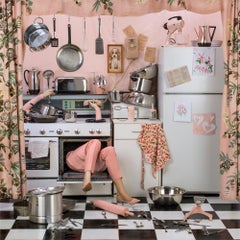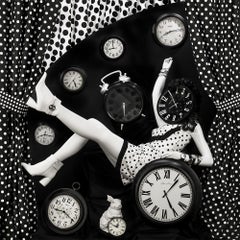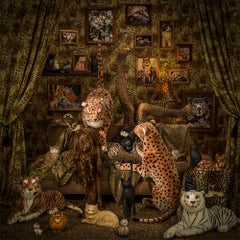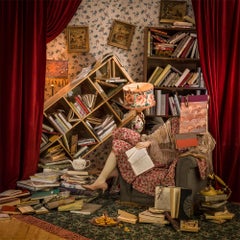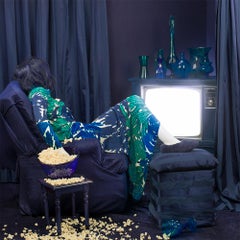Digital Pigment Figurative Photography
to
14
63
45
20
32
91
Overall Width
to
Overall Height
to
56
197
2
1
3
4
2
7
3
140
20
18
8
8
1
139
63
49
140
82
35
34
27
23
23
22
20
19
19
17
17
16
15
13
13
13
13
13
2,869
7,930
6,945
5,775
5,572
34
34
28
16
14
32
16
186
67
Medium: Digital Pigment
Cooking the Goose
Located in Carmel-by-the-Sea, CA
Photograph available in 15 x 15" (edition of 20), 22 x 22" (edition of 20) and 38 x 38" (edition of 10). Availability and pricing is subject to change without notice. Patty Carroll h...
Category
Late 20th Century Digital Pigment Figurative Photography
Materials
Digital Pigment
Price Upon Request
Clockwork
Located in Carmel-by-the-Sea, CA
Photograph available in 15 x 15" (edition of 20), 22 x 22" (edition of 20) and 38 x 38" (edition of 10). Availability and pricing is subject to change without notice. Patty Carroll h...
Category
Late 20th Century Digital Pigment Figurative Photography
Materials
Digital Pigment
Price Upon Request
Cat Lady
Located in Carmel-by-the-Sea, CA
Photograph available in 15 x 15" (edition of 20), 22 x 22" (edition of 20) and 38 x 38" (edition of 10). Availability and pricing is subject to change without notice. Patty Carroll h...
Category
Late 20th Century Digital Pigment Figurative Photography
Materials
Digital Pigment
Price Upon Request
Canned
Located in Carmel-by-the-Sea, CA
Photograph available in 15 x 15" (edition of 20), 22 x 22" (edition of 20) and 38 x 38" (edition of 10). Availability and pricing is subject to change without notice. Patty Carroll h...
Category
Late 20th Century Digital Pigment Figurative Photography
Materials
Digital Pigment
Price Upon Request
Booky
Located in Carmel-by-the-Sea, CA
Photograph available in 15 x 15" (edition of 20), 22 x 22" (edition of 20) and 38 x 38" (edition of 10). Availability and pricing is subject to change without notice. Patty Carroll h...
Category
Late 20th Century Digital Pigment Figurative Photography
Materials
Digital Pigment
Price Upon Request
Blues
Located in Carmel-by-the-Sea, CA
Photograph available in 15 x 15" (edition of 20), 22 x 22" (edition of 20) and 38 x 38" (edition of 10). Availability and pricing is subject to change without notice. Patty Carroll h...
Category
Late 20th Century Digital Pigment Figurative Photography
Materials
Digital Pigment
Price Upon Request
Blue Dots and Painting
Located in Carmel-by-the-Sea, CA
Photograph available in 15 x 15" (edition of 20), 22 x 22" (edition of 20) and 38 x 38" (edition of 10). Availability and pricing is subject to change without notice. Patty Carroll h...
Category
Late 20th Century Digital Pigment Figurative Photography
Materials
Digital Pigment
Price Upon Request
Blue Blue Birds
Located in Carmel-by-the-Sea, CA
Photograph available in 15 x 15", 22 x 22" and 38 x 38." Availability and pricing is subject to change without notice. Patty Carroll has been known for her use of highly intense, sat...
Category
Late 20th Century Digital Pigment Figurative Photography
Materials
Digital Pigment
Price Upon Request
Accessoriesy
Located in Carmel-by-the-Sea, CA
Patty Carroll has been known for her use of highly intense, saturated color photographs since the 1970’s. Her most recent project, “Anonymous Women,” consists of a 3-part series of s...
Category
Late 20th Century Digital Pigment Figurative Photography
Materials
Digital Pigment
Price Upon Request
Moulin Rouge
Located in Kansas City, MO
Title: Moulin Rouge
Medium: Photograph on paper
Date: 2017
Dimensions: Multiple Sizes Available (please inquire within)
Description: View of the Moulin Ro...
Category
2010s Contemporary Digital Pigment Figurative Photography
Materials
Digital Pigment
Price Upon Request
Architecture
Located in Kansas City, MO
Title: Architecture
Medium: Photograph on paper
Date: 2017
Dimensions: Multiple Sizes Available (please inquire within)
Description: Black and white photograph of Kansas City's Kauff...
Category
2010s Contemporary Digital Pigment Figurative Photography
Materials
Digital Pigment
Price Upon Request
von Unwerth, Tree of Love, Bavaria, Nude, Color Photography, Fine Art Print
Located in Los Angeles, CA
Tree of Love, Bavaria, 2015
C-print on Fujiflex paper
70.8 x 47.2 in (180 x 120 cm)
Edition of 3
The photographer
Ellen von Unwerth worked as a top fashion model for 10 years, before taking up the camera and becoming one of the world’s most in-demand fashion photographers. Her editorial work has featured in countless magazines, including Vogue, Interview, Vanity Fair, and i-D, while her major advertising campaigns include Victoria’s Secret, Banana Republic...
Category
2010s Digital Pigment Figurative Photography
Materials
Digital Pigment
River Raptors
By Steve Miller
Located in Hudson, NY
Listing is for FRAMED print.
Edition of 7.
CURRENT EXHIBITION - runs through December 18th, 2016. Any framed photographs purchased during the show will be available after December ...
Category
2010s Contemporary Digital Pigment Figurative Photography
Materials
Digital Pigment
Price Upon Request
Digital Pigment figurative photography for sale on 1stDibs.
Find a wide variety of authentic Digital Pigment figurative photography available on 1stDibs. While artists have worked in this medium across a range of time periods, art made with this material during the 21st Century is especially popular. If you’re looking to add figurative photography created with this material to introduce a provocative pop of color and texture to an otherwise neutral space in your home, the works available on 1stDibs include elements of blue, orange, purple, red and other colors. There are many well-known artists whose body of work includes ceramic sculptures. Popular artists on 1stDibs associated with pieces like this include Tyler Shields, Brian Finke, Raphael Macek, and Ali Alışır. Frequently made by artists working in the Contemporary, Photorealist, all of these pieces for sale are unique and many will draw the attention of guests in your home. Not every interior allows for large Digital Pigment figurative photography, so small editions measuring 0.79 inches across are also available
